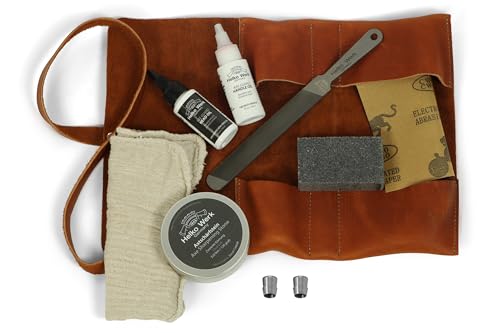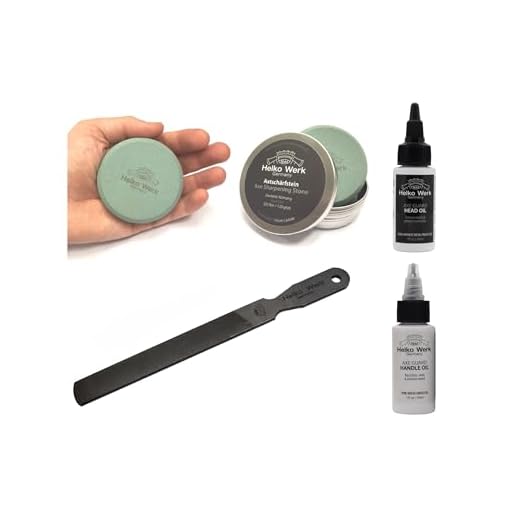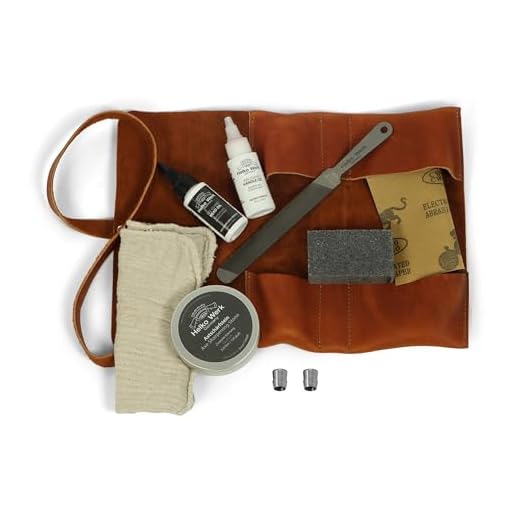


Sharpening an axe can be a daunting task, especially if you’re new to the world of axe maintenance. Axes are essential tools for many outdoor activities, such as camping, hiking, and chopping firewood. Over time, an axe blade can become dull and lose its effectiveness. One common question that often arises is whether sandpaper can be used to sharpen an axe.
The short answer is yes, sandpaper can be used to sharpen an axe. Sandpaper is a versatile tool that can help restore the sharpness of an axe blade. However, it is important to note that sharpening an axe with sandpaper requires a specific technique to achieve the desired results.
When using sandpaper to sharpen an axe, it is crucial to select the right grit level. Coarse grits, such as 80 or 120, are ideal for removing nicks and rough edges from the blade. Finer grits, such as 220 or 320, can be used for honing and refining the edge. It’s important to remember that sanding an axe blade should be done with caution to avoid removing too much material or altering the overall shape of the blade.
In conclusion, sandpaper can be a useful tool for sharpening an axe. However, it is important to approach the task with care and use the right grit level based on the condition of your axe. Regular maintenance and sharpening will not only improve the performance of your axe but also prolong its lifespan. So, next time you notice your axe blade losing its edge, consider using sandpaper to bring back its sharpness!
Can axe blade be sharpened with sandpaper?
Sharpening an axe blade is important to maintain its efficiency and effectiveness. While there are several methods to achieve a sharp edge on an axe, using sandpaper can be a viable option.
Sandpaper is an abrasive material that can remove small amounts of metal from the blade, gradually shaping it into a sharper form. However, it is important to note that sandpaper should not be the only method used for sharpening an axe, especially if the blade is severely dull or damaged.
Steps to sharpen an axe blade with sandpaper:
1. Prepare the necessary materials: sandpaper with different grits (ranging from coarse to fine), a flat surface or sharpening stone, and safety equipment (gloves and eye protection).
2. Inspect the axe blade for any chips, nicks, or other forms of damage. If there are serious issues, it may be best to consult a professional or replace the axe.
3. Start with a coarse-grit sandpaper. Wet the sandpaper or soak it in water for a few minutes to prevent clogging and improve its effectiveness.
4. Hold the sandpaper firmly against a flat surface or sharpening stone, ensuring the blade is positioned at an angle of about 20 to 30 degrees.
5. Using moderate pressure, move the axe blade across the sandpaper in a consistent and controlled manner. Make sure to maintain the same angle throughout the process.
6. Repeat the process on each side of the blade, checking for progress and assessing the sharpness as you go. Be patient and take your time.
7. Once the desired sharpness is achieved, switch to a finer-grit sandpaper to refine the edge further. Follow the same steps as before, moving from the coarser grit to the finer grit.
8. After using the sandpaper, it is recommended to reestablish the bevel of the blade by honing it with a sharpening stone or a honing guide.
Remember, using sandpaper for axe blade sharpening is a gradual process that requires patience and attention to detail. It may not be suitable for heavily damaged blades or if a quick fix is needed. Always prioritize safety and consider seeking professional help if unsure about the proper sharpening method.
Tools required for sharpening an axe with sandpaper
Sharpening an axe with sandpaper is a simple and cost-effective method that can be done at home with the right tools. To effectively sharpen your axe, you will need the following tools:
| Tools | Description |
|---|---|
| Sandpaper | Choose sandpaper with a coarse grit, ideally 60-80 grit, to remove the dull edges of the axe blade effectively. |
| Flat surface | You will need a flat surface, such as a workbench or table, to secure the axe during sharpening. |
| Vise or clamps | To hold the axe securely in place during sharpening, you will need a vise or clamps that can be attached to the flat surface. |
| File | A file will be used to remove any burrs or imperfections from the blade during the sharpening process. |
| Water | Having water nearby is important to keep the sandpaper and axe blade moist, which helps prevent overheating and improves the sharpening process. |
| Protective gloves and eyewear | Sharpening an axe can be a potentially hazardous process, so it is crucial to wear protective gloves and eyewear to prevent accidents and injury. |
By using these tools and following the proper technique, you can sharpen your axe blade with sandpaper and ensure it remains sharp for effective use in tasks such as wood chopping and cutting.
Step-by-step guide to sharpening an axe blade with sandpaper
Sharpening an axe blade with sandpaper is a cost-effective and simple way to maintain the cutting prowess of your axe. Though it may not be as quick as using a sharpening stone or a grinder, sandpaper can still get the job done effectively. In this step-by-step guide, we will walk you through the process of sharpening your axe blade using sandpaper.
Step 1: Gather the materials
Before you begin, make sure you have the following materials:
- An old towel or sheet to protect your work surface
- A pair of gloves for hand protection
- A coarse-grit sandpaper (around 80-100 grit) for initial sharpening
- A medium-grit sandpaper (around 150-220 grit) for refining the edge
- A fine-grit sandpaper (around 320-400 grit) for finishing touches
- A flat file or a round file to reshape the cutting edge (optional)
Step 2: Secure the axe
Find a sturdy work surface and secure the head of the axe with a vice or clamp, allowing the blade to be easily accessible. Make sure the axe is stable and won’t move during the sharpening process.
Step 3: Begin with coarse-grit sandpaper
Start the sharpening process by using the coarse-grit sandpaper. Hold the sandpaper firmly on the blade and move it back and forth along the cutting edge. Make sure to maintain a consistent angle throughout the process. This will help remove any nicks or dullness from the blade. Repeat this motion several times until the blade starts to feel sharper.
Step 4: Switch to medium-grit sandpaper
Once the blade feels sharper, switch to the medium-grit sandpaper to further refine the edge. Follow the same back and forth motion along the cutting edge, ensuring an even and smooth sharpening process. This step helps to remove any coarse scratches left by the previous sandpaper.
Step 5: Finish with fine-grit sandpaper
For the final touches, use the fine-grit sandpaper to achieve a polished finish. This step helps to smooth out any remaining roughness on the blade and ensures a sharp cutting edge. Repeat the back and forth motion until you achieve the desired sharpness.
Step 6: Optional: Reshape the cutting edge
If your axe blade has significant damage or dullness, you may need to reshape the cutting edge using a flat file or a round file. Carefully file the edge at the desired angle to restore its sharpness. This step should only be done if necessary and with caution.
Step 7: Clean and oil the axe
Once you are satisfied with the sharpness of the blade, clean off any residual sanding dust and apply a light coat of oil to prevent rusting. This will keep your axe in optimal condition and ready for use.
By following these step-by-step instructions, you can effectively sharpen your axe blade using sandpaper. Remember to take your time and be cautious throughout the process to achieve the best results. Happy sharpening!
Precautions to take while sharpening an axe with sandpaper
Sharpening an axe with sandpaper can be an effective method to restore its cutting edge. However, it’s important to take certain precautions to ensure your safety and the quality of the sharpening process. Below are some precautions you should consider:
- Wear protective gear: Before sharpening your axe with sandpaper, make sure to wear appropriate protective gear such as safety goggles, gloves, and a dust mask. This will protect you from any potential injury or irritation caused by flying debris or particles.
- Choose the right sandpaper grit: Selecting the correct sandpaper grit is crucial for achieving the desired sharpening result. Coarse grits (around 120-150) are suitable for removing nicks and reshaping the blade, while finer grits (around 220-400) are ideal for polishing and refining the edge.
- Secure the axe properly: It’s important to securely fasten the axe in a vice or clamp before starting the sharpening process. This will prevent any accidents or injuries caused by the axe slipping or moving during sharpening.
- Maintain a consistent angle: While sharpening the axe, try to maintain a consistent angle along the blade. This will ensure an even sharpening and prevent uneven or lopsided edges. Using a sharpening guide or angle jig can be helpful in achieving a consistent angle.
- Use even and steady strokes: When using sandpaper to sharpen the axe, use even and steady strokes along the blade. Applying excessive pressure or using erratic movements can lead to uneven sharpening and may damage the axe.
- Check for burrs regularly: While sharpening, periodically check the blade for burrs or wire edges that can form during the sharpening process. Remove these burrs by using a fine-grit sandpaper or a deburring tool to ensure a smooth and sharp cutting edge.
- Clean and oil the axe: After sharpening, clean any debris or particles from the axe blade. Apply a thin coat of oil to help protect the blade from rust and corrosion.
By following these precautions, you can safely and effectively sharpen your axe with sandpaper, ensuring a sharp and efficient cutting tool for your needs.
Pros and Cons of Sharpening Axe with Sandpaper
When it comes to sharpening an axe, there are several methods to choose from. One popular method is using sandpaper to sharpen the blade. This technique has both its advantages and disadvantages, which we will discuss in this article.
Pros
1. Accessibility: Sandpaper is easily accessible and can be found in most hardware stores. It is a relatively inexpensive tool compared to other sharpening methods, making it a convenient option for many axe owners.
2. User-friendly: Using sandpaper to sharpen an axe requires minimal skill and expertise. It is a straightforward process that even beginners can easily learn and perform successfully.
3. Versatility: Sandpaper can be used to sharpen axes made from various materials, including carbon steel and stainless steel. Whether your axe has a soft or hard blade, sandpaper can effectively remove burrs and restore a keen edge.
Cons
1. Time-consuming: Sharpening an axe with sandpaper can be a time-consuming process, especially if the blade is severely dull or damaged. It requires patience and persistence to achieve a satisfactory result.
2. Limited effectiveness: While sandpaper can sharpen an axe blade to some extent, it may not provide the same level of sharpness as some other sharpening methods, such as using a grindstone or a file. If you require a razor-sharp edge, sandpaper may not be the best option.
3. Inconsistent results: The effectiveness of sharpening an axe with sandpaper can vary depending on the user’s technique and the quality of the sandpaper used. Achieving a consistent and even sharpening angle may require some practice and experimentation.
In conclusion, sharpening an axe with sandpaper has its advantages and disadvantages. It is an accessible and user-friendly method that can be used on axes made from different materials. However, it may be time-consuming and not as effective as other sharpening techniques. Consider your needs and preferences before deciding whether to use sandpaper for axe sharpening.
Alternative methods for sharpening an axe blade
While using sandpaper to sharpen an axe blade is a popular method, there are also alternative methods that can be effective in achieving a sharp edge. These methods include:
Using a file: A file is a common tool used to sharpen an axe blade. It is important to use a file specifically designed for metal, as this will provide the best results. To sharpen the axe, hold the file at a 20-degree angle to the blade and run it along the edge, applying consistent pressure. Repeat this process until the blade is sharp.
Using a honing stone: A honing stone is another traditional method for sharpening an axe blade. Soak the honing stone in water for a few minutes to ensure proper lubrication, then hold the stone firmly and move the blade across it in a circular motion. Be sure to maintain a consistent angle and apply even pressure. Continue this process until the blade is sharp.
Using a grinding wheel: If you have access to a grinding wheel, it can be an effective tool for sharpening an axe blade. Start by adjusting the tool rest on the grinding wheel to the desired blade angle. Carefully hold the axe blade against the grinding wheel, ensuring that it is evenly in contact with the surface. Move the blade back and forth across the grinding wheel, applying gentle pressure and maintaining a steady motion. Check the sharpness of the blade periodically and continue grinding until the desired sharpness is achieved.
Regardless of the method chosen, it is important to take safety precautions when sharpening an axe blade. Wear protective gloves and eyewear, and ensure that the work area is well-ventilated. Always follow the manufacturer’s instructions for the specific sharpening method and take breaks as needed to avoid overheating the blade.







